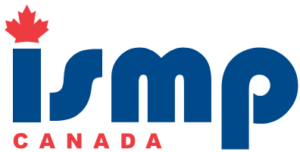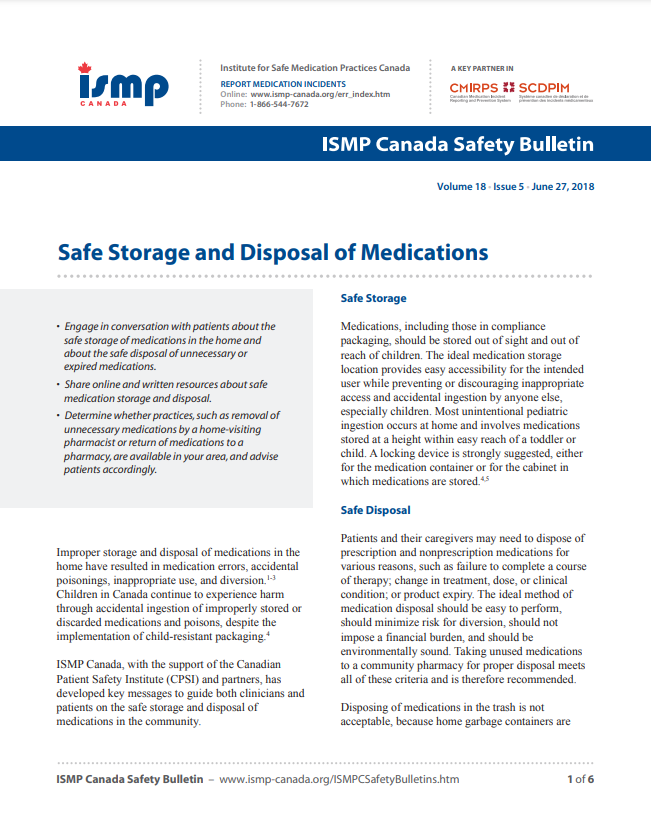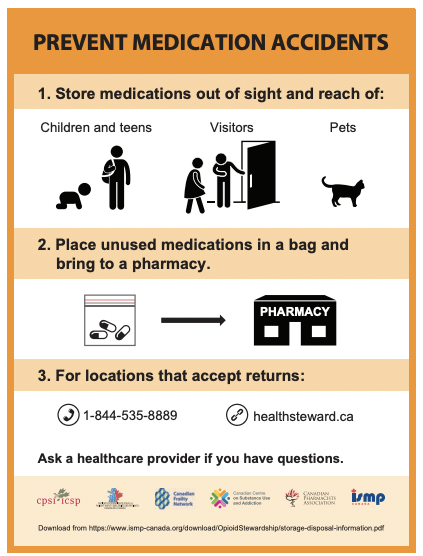Safe Storage and Disposal of Medications
This bulletin, created in partnership with the Canadian Patient Safety Institute offers guidance to clinicians and patients on the safe storage and disposal of medications in the community.
𝗦𝗶𝗱𝗲𝗯𝗮𝗿𝘀:
- Safety Concerns Resulting from a Concentrated Potassium Chloride Shortage in the United States
- Canada’s National Incident Data Repository for Community Pharmacies
- Using Your Own Medications While in Hospital
- Engage in conversation with patients about the safe storage of medications in the home and about the safe disposal of unnecessary or expired medications.
- Share online and written resources about safe medication storage and disposal.
- Determine whether practices, such as removal of unnecessary medications by a home-visiting pharmacist or return of medications to a pharmacy, are available in your area, and advise patients accordingly.
INTRODUCTION
Improper storage and disposal of medications in the home have resulted in medication errors, accidental poisonings, inappropriate use, and diversion.1-3 Children in Canada continue to experience harm through accidental ingestion of improperly stored or discarded medications and poisons, despite the implementation of child-resistant packaging.4
ISMP Canada, with the support of the Canadian Patient Safety Institute (CPSI) and partners, has developed key messages to guide both clinicians and patients on the safe storage and disposal of medications in the community.
SAFE STORAGE
Medications, including those in compliance packaging, should be stored out of sight and out of reach of children. The ideal medication storage location provides easy accessibility for the intended user while preventing or discouraging inappropriate access and accidental ingestion by anyone else, especially children. Most unintentional pediatric ingestion occurs at home and involves medications stored at a height within easy reach of a toddler or child. A locking device is strongly suggested, either for the medication container or for the cabinet in which medications are stored.4,5
SAFE DISPOSAL
Patients and their caregivers may need to dispose of prescription and nonprescription medications for various reasons, such as failure to complete a course of therapy; change in treatment, dose, or clinical condition; or product expiry. The ideal method of medication disposal should be easy to perform, should minimize risk for diversion, should not impose a financial burden, and should be environmentally sound. Taking unused medications to a community pharmacy for proper disposal meets all of these criteria and is therefore recommended.
Disposing of medications in the trash is not acceptable, because home garbage containers are often vulnerable to access by children and pets, as well as to drug diversion. Although flushing medications down the toilet has often been used as a disposal alternative, there are compelling arguments against widespread use of this practice, given that the potential environmental and health impact of most products is unknown.6,7 The US Food and Drug Administration has published a list of medicines, notably potent opioids, for which disposal by flushing may be acceptable when more responsible, take-back options are not readily available.6
Topical patches containing opioids, such as fentanyl and buprenorphine, pose unique disposal risks. The Patch-for-Patch Fentanyl Return Policy is an Ontario legislative initiative8,9 that aims to reduce the risk of harm; evaluation of this program will be of interest.
The website of the Health Products Stewardship Association (HPSA) provides information about locations and processes for safe medication disposal in every Canadian province. The HPSA also administers medication return programs for participating pharmacies in British Columbia, Manitoba, Ontario, and Prince Edward Island; through these programs, patients can take unneeded medications to participating pharmacies (Box 1). In addition, HPSA, its partners, and participating pharmacies conduct an annual campaign encouraging families to declutter their medicine cabinets and to return unneeded and expired medicines to the pharmacy.

Box 1. Examples of items that can be returned to participating pharmacies in British Columbia, Manitoba, Ontario, and Prince Edward Island:
SPECIAL CIRCUMSTANCES
Upon the death of a person who has been receiving palliative or end-of-life care in the home, the family is often left to dispose of the patient’s unused medications. A “situation assessment” was conducted at an Ontario hospital by a multidisciplinary team to evaluate methods for disposal of unused medications in these circumstances.10 The study objectives were to identify preferred practices and to provide educational materials for families and healthcare providers with the ultimate goal of improving medication storage and disposal in these cases. A suitable action identified by the team was to have a pharmacist conduct an in-home medication review and remove unused medications. Another good practice is to have the home care service provider pick-up symptom relief kits* when they are no longer needed.10 These practices can facilitate the appropriate return and disposal of unused medications.
RESOURCES FOR PATIENTS AND FAMILIES
ISMP Canada is working with several partners, including the CPSI and Patients for Patient Safety Canada, to integrate key messaging about safe storage and disposal of medications into various patient resources. “Prevent Medication Accidents” (Figure 1) is an information card developed to provide key information for patients and families about proper storage and disposal of unnecessary medications in the home.11
Another resource handout was developed to address the proper use, secure storage, and disposal of opioids prescribed to treat pain after surgery (Figure 2).12 This information card was built on the “5 Questions to Ask about Your Medications” movement and was launched by Choosing Wisely Canada as part of the Opioid Wisely campaign.
Healthcare providers can order complimentary resources from HPSA to promote safe disposal of medications to the public. The resources and order form are available from: https://www.ismp-canada.org/opioid_stewardship/ (see Storage and Disposal tab).
* A symptom relief kit is a “standardized package of medications and related medical supplies provided to a patient who is approaching end-of-life for the purpose of relieving unanticipated or rapidly escalating symptoms” (Hospice Palliative Care Teams for Central LHIN, Toronto, ON; http://www.centralhealthline.ca/healthlibrary_docs/SymptomManagementKit.pdf).
CONCLUSION
To prevent medication-related harm, patients and family members should receive clear guidance about the appropriate storage of all medications, as well as the disposal of unnecessary ones. Patient and consumer organizations, hospitals, pharmacies, community care providers, and provincial and national organizations are all well positioned to integrate key messages into resources for and conversations with patients and their families. Contact info@ismpcanada.ca for additional information about knowledge dissemination and translation initiatives for these important patient safety messages.
![]()
The Canadian Medication Incident Reporting and Prevention System (CMIRPS) is a collaborative pan-Canadian program of Health Canada, the Canadian Institute for Health Information (CIHI), the Institute for Safe Medication Practices Canada (ISMP Canada) and Healthcare Excellence Canada (HEC). The goal of CMIRPS is to reduce and prevent harmful medication incidents in Canada.
Funding support provided by Health Canada. The views expressed herein do not necessarily represent the views of Health Canada.

The Healthcare Insurance Reciprocal of Canada (HIROC) provides support for the bulletin and is a member owned expert provider of professional and general liability coverage and risk management support.

The Institute for Safe Medication Practices Canada (ISMP Canada) is an independent national not-for-profit organization committed to the advancement of medication safety in all healthcare settings. ISMP Canada’s mandate includes analyzing medication incidents, making recommendations for the prevention of harmful medication incidents, and facilitating quality improvement initiatives.
Report Medication Incidents (Including near misses)
Online: ismpcanada.ca/report/
Phone: 1-866-544-7672
ISMP Canada strives to ensure confidentiality and security of information received, and respects the wishes of the reporter as to the level of detail to be included in publications.
Stay Informed
Subscribe to the ISMP Canada Safety Bulletins and Newsletters.
This bulletin shares information about safe medication practices, is noncommercial, and is therefore exempt from Canadian anti-spam legislation.
Contact Us
Email: cmirps@ismpcanada.ca
Phone: 1-866-544-7672
©2025 Institute for Safe Medication Practices Canada.


